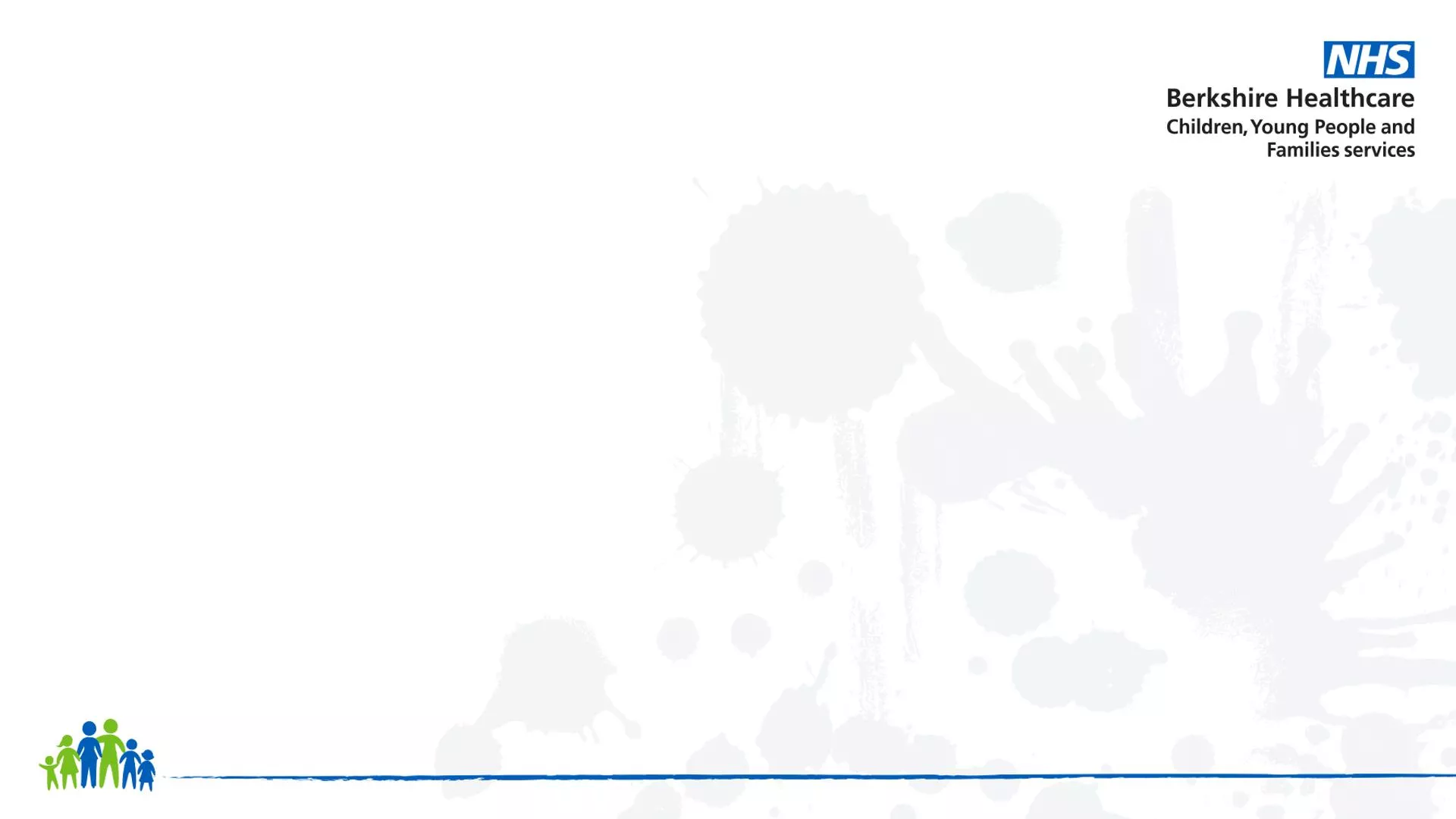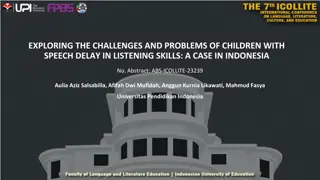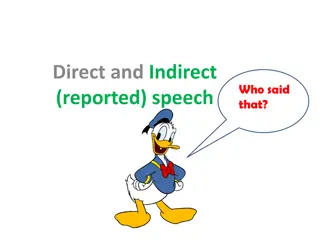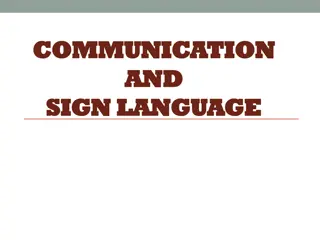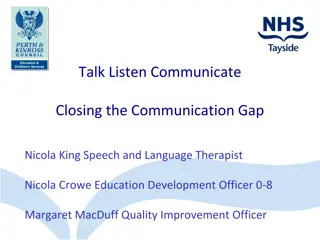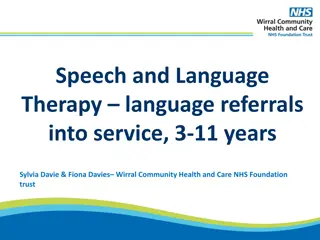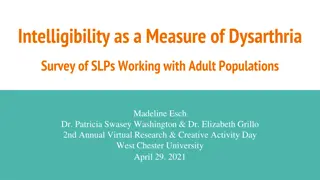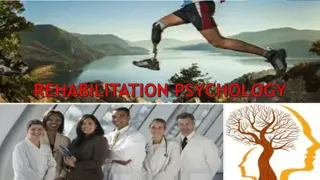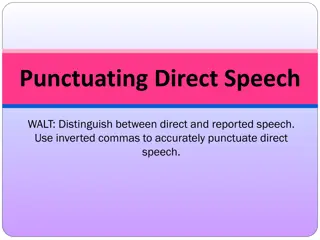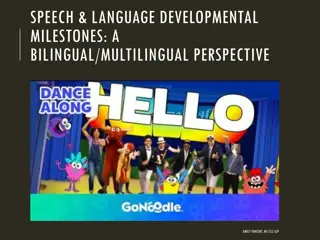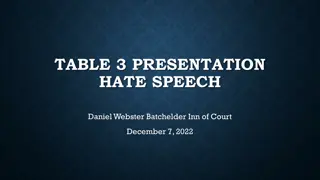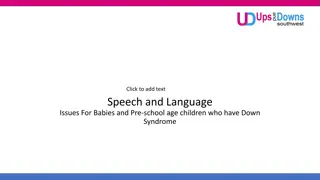Speech, Language, and Communication Development in Children
Explore the world of speech, language, and communication therapy for children, covering topics like building blocks, circles of support, effective communication strategies, and fostering growth in communication skills. Learn about the importance of listening, responding, and creating a supportive environment for children's communication development.
Download Presentation

Please find below an Image/Link to download the presentation.
The content on the website is provided AS IS for your information and personal use only. It may not be sold, licensed, or shared on other websites without obtaining consent from the author.If you encounter any issues during the download, it is possible that the publisher has removed the file from their server.
You are allowed to download the files provided on this website for personal or commercial use, subject to the condition that they are used lawfully. All files are the property of their respective owners.
The content on the website is provided AS IS for your information and personal use only. It may not be sold, licensed, or shared on other websites without obtaining consent from the author.
E N D
Presentation Transcript
Communication building blocks Speech and Language Therapy CYPIT
Disclaimer The purpose of the session today is to provide you with information on strategies which can be used with your child to support the development of their speech, language and communication skills. By attending this webinar, you are not referring your child to the Speech and Language Therapy service. You are welcome to use the Q&A function to ask questions. Given that this is a TEAMs webinar and is not designed to provide specific clinical intervention, any identifiable information you provide about your child will not be processed or retained. Should you provide information regarding your child, we will not use this unless there is an identified safeguarding concern. My colleague is monitoring messages being sent to us to identify questions which require a response. Messages with identifiable information will not be published. If this is the case, data will be used to escalate appropriately to the safeguarding team
Circles of support/ influence General Practitioner Occupational Therapist Nursery staff f Family Working together: The people who will be able to make the most change are those closest to the child Child Respite Keyworker SEND Team Falvey, M. A., Forest, M., Pearpoint, J., & Rosenberg, R. L. (1997) Speech and Language Therapist Dietitian Physiotherapist
Consider this: What makes you want to communicate?
Communication What makes someone good to talk to? Listen Respond Use eye contact Don t interrupt Be interested in what your conversation partner is saying Use open body language Don t ask too many questions Don t take over the conversation
Speech, language and communication Speech is the ability to combine sounds into words. Language is talking (expressive) and understanding (receptive). Communication is how we interact with others.
Communication Tree Leaves and blossom Your child pronounces all their letters/sounds properly Branches Your child says lots of different words and uses sentences Environment For communication to grow, children need those around them to: Trunk Your child understands what you are saying Use language at the right level Use the language the adult is most comfortable speaking Enjoyment of being with someone Understanding that communication can influence a person Roots Listening Play Desire to communicate Turn-taking Attention control
Strategy 1: Get face-to-face Connect and share in the moment Notice what your child is interested in Mirror facial expressions, gestures and sounds Respond to any attempts of communication
Strategy 2: Allow the child to lead Watch for what your child is interested in Wait for your child to start the interaction Listen to your child (with ears and eyes!) Respond with interest
Strategy 2: Allow the child to lead Ways to respond to your child: Copy their actions and sounds 1. Interpret their actions and sounds 2. Join in and play 3. Comment on what is happening 4.
Food for thought: When children lead they get the language they need!
Strategy 3: Four comments to one question Your thumb represents one question, e.g. what s that? Make four comments about what is happening before asking another question
Means, reasons and opportunities For a child to communicate, they need the three following things: Means Means Does the child have a reliable method of communication that they know how to use? Functional communication Opportunities Does the child have an opportunity to use their communication skills? Reasons Opportunity Reasons Does this child have an irresistible reason to communicate with you?
Strategy 4: Creating opportunities Sabotaging is setting up situations/problems so that a child needs to communicate with you to get what they want. 1. Identify what s motivating to your child? 2. Give your child a reason by sabotaging! 3. Then pause for your child to notice 4. Provide the opportunity for communication by waiting 5. Respond immediately
Strategy 5: Creating opportunities Give them their food without cutlery, or with the wrong cutlery Give your child food in packaging they can t open, or put a favourite item in a transparent, hard-to-open container Give them the iPad/phone without entering the passcode Give them a marble run without the marbles, or set up a race track, but don t provide cars Put their favourite toy on a high shelf, out of reach Give them a battery- operated toy without the batteries, or give them a wind-up toy without winding it up first
Strategy 5: Giving choices Support the two choices visually with the object, picture or sign Start with a motivating and less motivating item when making choices Examples: do you want a yoghurt or top? do you want juice or water? is he running or jumping? is he sitting in the kitchen or dancing in the kitchen? is it in or on?
Strategy 6: Vocabulary Make sure words are functional and link with your child s interests Repeat and emphasise these words Use clues Keep it positive! Try to use a range of different words
Strategy 6: Vocabulary Question words Action words Words that express belonging Naming words Location words Descriptive words Feelings Social words
Strategy 6: Vocabulary Question words Where Who What Where s the car going? Action words Go Drive Wash Turn Move Pull Push Gone Words that express belonging Mine Yours Hers Sam s Mummy s Daddy s Naming words Fast Big Broken Small Shiny Location words On Under In Behind In front Car colours Descriptive words Fast Big Broken Small Shiny Feelings Happy Sad Scary Social words Hello Bye Thank you Brum-brum Ta colours
Strategy 6: Vocabulary Question words Where s baby? How many? What s her name? Words that express belonging My Your [Child s name] s Mummy s Daddy s Dolly s Action words Cuddle Dress Cry Sleep Waving Feeding Pushing Location words On Under In Behind In front Naming words Baby Bottle Nappy Tummy Home Eyes Dolly Feelings Happy Sad Tired Grumpy Hungry Descriptive words Long/short [hair] Big Small Colours Social words Hello Bye
Strategy 7: Match + 1 Expand your child s communication attempts Match + 1 examples: Child: car Adult: bluecar Child: kick ball Adult: boykicking ball Be sure to use different types of words Your child does not have to repeat it back the emphasis is on modelling
Strategy 8: Books and songs Rhyming stories and songs can help your child develop their anticipation skills Reading with your child helps them to develop their attention, listening and language skills If your child knows a story or song well, why not try pausing to give them an opportunity to join in!
Language takes time to develop To see progress, these strategies need to be used daily
To recap: 1. Get face to face 2. Allowing the child to lead 3. Four comments to one question 4. Creating opportunities 5. Giving choices 6. Vocabulary 7. Match +1 8. Books and songs
Good relationshipslead to good communication Good communicationleads to good relationships
Thank you for listening Further help can be found via our website: cypf.berkshirehealthcare.nhs.uk/communication


